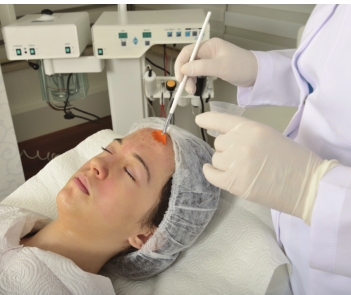PHOTODYNAMIC THERAPY

More ammunition against acne!
 If you have moderate acne, take a few minutes to answer these questions and learn about a unique treatment option for acne.
If you have moderate acne, take a few minutes to answer these questions and learn about a unique treatment option for acne.
1. Are you tired of taking oral medications every day for acne?
2. Are you often worried about the side effects of some of these drugs?
3. Would you like an option that eliminates messy topical treatments?
If you answered “yes” to these questions, Blue Light photodynamic therapy may be right for you.
Photodynamic therapy is a nondrug treatment for moderate acne. It works by killing propionibacterium acnes bacteria, which are located in the oil glands of the skin. Acne is caused when these oil glands (sebaceous glands) become clogged. Propionibacterium acnes bacteria grow in these glands, metabolize the oil and produce fatty acids which cause inflammation (zits).
At certain times in life, particularly teenage years, this process can become hard to control. Treatments involve unclogging the oil glands, killing bacteria, decreasing oil production, changing cell turnover and decreasing inflammation. Any or all of these may be used in combination therapy.
 The advantage of Blue Light treatment is that there are relatively few side effects. You come into the office usually two times a week for treatments. During each treatment, you sit under a blue light for about 16 minutes. The treatment is very gentle and has no downtime. The length of the therapy varies, depending on the severity of the acne. Periodically, treatment may have to be repeated.
The advantage of Blue Light treatment is that there are relatively few side effects. You come into the office usually two times a week for treatments. During each treatment, you sit under a blue light for about 16 minutes. The treatment is very gentle and has no downtime. The length of the therapy varies, depending on the severity of the acne. Periodically, treatment may have to be repeated.
Other nonantibiotic treatments may also help to unclog pores. Photodynamic therapy may be combined with light chemical peels and/ or acne facials with extractions, and, while photodynamic therapy may be used by itself, often a multifaceted approach (antibiotics, topicals, proper skin care) may give faster and longer lasting satisfaction.
For the severest cystic acne, photodynamic therapy may not be enough. There is still a subset of patients who need the “big gun,” Accutane. While Accutane, or isotretinoin, has increased side effects compared to certain other therapies, it clears almost all acne, and the majority of those patients remain clear after stopping therapy. Accutane also has a definite beginning and end, unlike all of the other treatments, which may require years.
Seeing a dermatologist should be your first step, if over-the-counter regimens have failed. A dermatologist will diagnose the type of acne (yes, there is more than one kind) and select the appropriate therapy. At our clinic, we know that comedonal acne (blackheads and whiteheads) are not treated the same way as deep, painful cysts.
Make an appointment with your dermatologist soon so that you will be ready for your close-up!
Josephine Futrell, MD, PhD, is a partner at Ark-La-Tex Dermatology with offices in Bossier City and Shreveport, part of the Willis-Knighton Physician Network.
